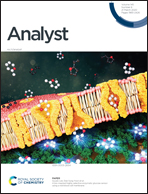An FcεRI-IgE-based genetically encoded microfluidic cell sensor for fast Gram-negative bacterial screening in food samples†
Abstract
An FcεRI-IgE-based genetically encoded microfluidic cell sensor was constructed for fast Gram-negative bacterial screening in food samples. CD14-Fcε IgE, produced by the gene engineered antibodies (GEAs) technology, was used for the recognition of the target bacteria or lipopolysaccharide (LPS). Stable cell lines expressing GCaMP6s, a genetically encoded indicator of calcium flux, were first established for monitoring mast cell activation and improving detection sensitivity. The microfluidic system was designed to improve automation and control the reaction time. Once Gram-negative bacteria bound to the CD14-Fcε IgE on the RBL-2H3 cell surface, RBL-2H3 cell receptor (FcεRI)-induced Ca2+ signaling pathway was immediately activated to release Ca2+. The elevated intracellular Ca2+ triggers GCaMP6s for reporting the presence of Gram-negative bacteria. The developed biosensor was able to detect 80 CFU mL−1 Gram-negative bacteria within 2.5 min in pure culture samples. The biosensor was used to detect Gram-negative bacteria in pork samples. With its short screening time and easy operation, the proposed biosensor shows promise in future applications of foodborne pathogen testing in 1 h to 1 day.



 Please wait while we load your content...
Please wait while we load your content...